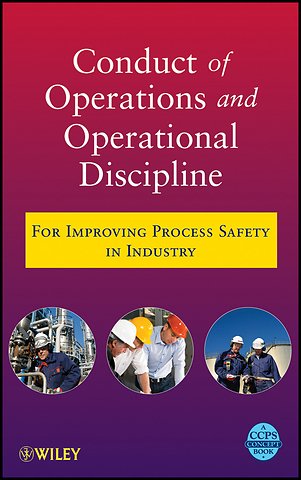Conduct of Operations and Operational Discipline – For Improving Process Safety in Industry
For Improving Process Safety in Industry
Gebonden Engels 2011 9780470767719Samenvatting
Process safety management (PSM) systems are only as effective as the day–to–day ability of the organization to rigorously execute system requirements correctly every time. The failure of just one person in completing a job task correctly just one time can unfortunately lead to serious injuries and potentially catastrophic incidents. In fact, the design, implementation, and daily execution of PSM systems are all dependent on workers at all levels in the organization doing their job tasks correctly every time. High levels of Operational Discipline, therefore, help ensure strong PSM performance and overall operational excellence.
This book details management practices which help ensure rigor in executing process safety programs in order to prevent major accidents.
Specificaties
Lezersrecensies
Inhoudsopgave
<p>List if Figures.</p>
<p>Online Materials Accompanying This Book.</p>
<p>Acronyms and Abbreviations.</p>
<p>Glossary.</p>
<p>Acknowledgments.</p>
<p>Preface.</p>
<p>Executive Summary.</p>
<p>1. What is COO/OD and How Can I Tell If I Need It?</p>
<p>1.1 Introduction.</p>
<p>1.2 Purpose of This Book.</p>
<p>1.3 Focus and Intended Audience.</p>
<p>1.4 Definitions.</p>
<p>1.5 How to Use This Book.</p>
<p>1.6 How DO I Know If I Need to Improve my COO/OD.</p>
<p>1.7 Basic COO/OD Concepts.</p>
<p>1.8 Implementation of the COO/OD System.</p>
<p>1.9 Scope of the Book.</p>
<p>1.10 Relationship to Other Management System Frameworks.</p>
<p>1.11 Summary.</p>
<p>1.12 References.</p>
<p>2. Benefits of COO/OD.</p>
<p>2.1 Introduction.</p>
<p>2.2 Objectives of COO/OD.</p>
<p>2.3 Evolution of COO/OD Systems.</p>
<p>2.4 Summary.</p>
<p>2.5 References.</p>
<p>2.6 Additional Reading.</p>
<p>3. Leadership s Role and Commitment.</p>
<p>3.1 Introduction.</p>
<p>3.2 Achieving Greatness with COO/OD.</p>
<p>3.3 Leadership s Role in Instituting COO/OD.</p>
<p>3.4 Summary.</p>
<p>3.5 References.</p>
<p>3.6 Additional Reading.</p>
<p>4. The Importance of Human Factors.</p>
<p>4.1 Introduction.</p>
<p>4.2 Human Behavior Issues.</p>
<p>4.3 What Is a Human Error?</p>
<p>4.4 Common Misconceptions About Human Performance.</p>
<p>4.5 Categories of Human Errors.</p>
<p>4.6 Human Error Initiators.</p>
<p>4.7 How Does A COO/OD System Prevent and Mitigate Human Errors?</p>
<p>4.8 Relationship Between COO/OD and Other Common Human Performance Tools.</p>
<p>4.9 Getting Everyone Involved in Human Factors.</p>
<p>4.10 Human Factors Metrics.</p>
<p>4.11 Summary.</p>
<p>4.12 References.</p>
<p>4.13 Additional Reading.</p>
<p>5. Key Attributes of Conduct of Operations.</p>
<p>5.1 Introduction.</p>
<p>5.2 COO Applied of Process Safety Management Systems.</p>
<p>5.3 Organization of this Chapter.</p>
<p>5.4 COO Foundations.</p>
<p>5.5 People.</p>
<p>5.6 Process.</p>
<p>5.7 Plant.</p>
<p>5.8 Management Systems.</p>
<p>5.9 Summary.</p>
<p>5.10 References.</p>
<p>5.11 Additional Reading.</p>
<p>6. Key Attributes of Operational Discipline.</p>
<p>6.1 Introduction.</p>
<p>6.2 Organizational Attributes.</p>
<p>6.3 Individual Attributes.</p>
<p>6.4 Summary.</p>
<p>6.5 References.</p>
<p>6.6 Additional Reading.</p>
<p>7. Implementing and Maintaining Effective COO/OD Systems.</p>
<p>7.1 Introduction.</p>
<p>7.2 Develop a Plan.</p>
<p>7.3 Implement the Plan.</p>
<p>7.4 Monitor Progress.</p>
<p>7.5 Adjust the Plan and Continuously Improve.</p>
<p>7.6 Application to Different Roles.</p>
<p>7.7 Summary.</p>
<p>7.8 References.</p>
<p>7.9 Additional Reading. </p>
Rubrieken
- advisering
- algemeen management
- coaching en trainen
- communicatie en media
- economie
- financieel management
- inkoop en logistiek
- internet en social media
- it-management / ict
- juridisch
- leiderschap
- marketing
- mens en maatschappij
- non-profit
- ondernemen
- organisatiekunde
- personal finance
- personeelsmanagement
- persoonlijke effectiviteit
- projectmanagement
- psychologie
- reclame en verkoop
- strategisch management
- verandermanagement
- werk en loopbaan
